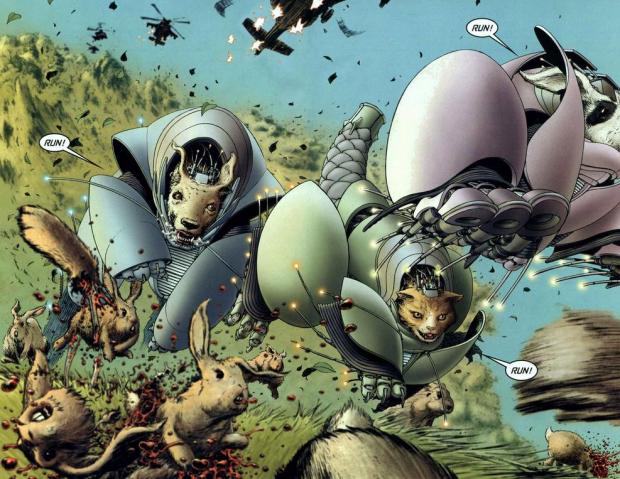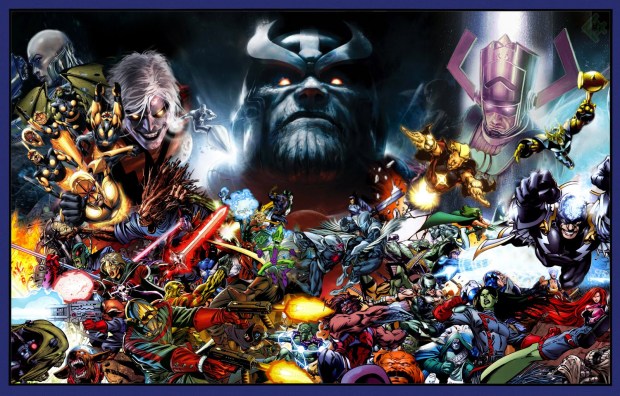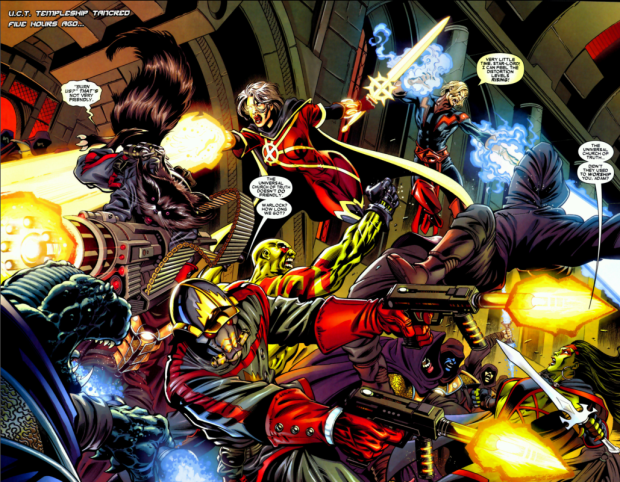Born in England (12th October 1965), Dan Abnett is a comic book writer, novelist and full time fantasist absorbed in the world of fantasy, space and superheroes. He has directed enormous future armies into cataclysmic battles, led mighty metal robots to clang together to save the universe, assassinated space empresses and sent heroes into space in wheelchairs. He is a frequent collaborator with fellow writer Andy Lanning, and is known for his work on books for both Marvel Comics, and their UK imprint, Marvel Uk, since the 1990s, including 2000AD. He has also contributed to DC Comics titles, and his Warhammer Fantasy and Warhammer 40,000 novels and graphic novels for Game Workshop’s Black Library now run to several dozen titles and have sold over 1,150,000 copies as of May 2008. In 2009 he released his first original fiction novels through Angry Robot books.

While Abnett cannot claim to have kick started a character on the same scale as Judge Dredd, the ABC Warriors or Slaine in his tenure at 2000AD, he did create one of the book’s better known and longest running strips of the last decade, Sinister Dexter, following the exploits of gun sharks (hitmen) Finnigan ‘Finny’ Sinister and Ramone ‘Ray’ Dexter in the state city of Downlode, sprawled across central Europe ‘ like a hit and run victim’. Sinister Dexter is a universe apart from that of Strontium Dog and Dredd, and style supplants horror, with neat and precise detailing throughout to give it an alternative edge that readers found addictive. With more than 135 stories alone to his name, most stretching to more than one issue, Abnett is one of the most prolific of all 2000AD writers, making his lack of success at generating a genuine globe trotting legend like Slaine or Dredd more down to bad luck than anything else.
Most likely in fact it’s lack of intent intent. Abnett’s style is pretty light, humorous and wry. His stories bound along and drag you with them. First and foremost is character, planted firmly at the heart of whatever dying star/ hive of alien warriors / dangerous street he can find. In Abnett’s universe character is secondary to event at times but only momentarily. Then, the characters bounce resolutely back into the frey and mash it up (for want of a better word). Abnett is addicted to failures. The almost-guy. Slaine and Dredd, much like Superman, Batman et al are a stall of successes. You put a criminal in his way, Dredd crushes dissent and puts them away. Slaine warp spasms, charms, wangles or shags his way out of every scenario. One of Abnett’s character steps into the frey he might as well be ready to lose an arm. Abnett’s characters are desperately, hilariously and touchingly out of their depth. This makes readers even more attached to the characters as they survive all that Abnett (and Lanning – to be featured in the following article) throw at them. Major characters are put to the sword, or in the case of perrenial space empress and Mutant headteacher beau du jour circa 1995, Empress Nerimani of the Shi’ar, who has wandered in and out of Marvel’s most prominent titles for decades, unceremoniously blown away by a sniper as part of a Darkhawk conspiracy. This, to anyone unfamiliar with the situation – is lunacy. Brilliant lunacy. You can almost see the grins on their faces as they decided it.

This was to move a nobody character, effectively unheard of since the ’90s into the foreground of an empire churning, galaxy battering epic in the guise of Marvel’s War of King’s series two years ago, in which stable, mainstay characters were supplanted, abused, annihalated, twisted and entire empires changed status. The scale of the effect on accepted rules of the wider Marvel Universe was mad, but Abnett and Lanning play with the planets and principle characters involved like so many ping pong balls. This, you suspect, was learned in the furnaces of the creative pool of 2000AD and the more blood thirsty Marvel UK. But more likely, they are just crazy bastards.
As well as a neat absurdist streak and a whithering habit of throwing humour at serious plot points (hard not to when your head tactician is a talking Raccoon but more on that later). He didn’t stop there. As well as generating Black Light, Badlands, Atavar (with Richard Elson, about the last Human alive trapped between warring alien races), Downlode Tales (an extension of the Sinister Dexter universe), Sancho Panzer (with Henry Flint, featuring the eponymous character piloting a giant tank, excellently monickered Mojo, with his brilliantly named technician, Tool), Roadkill and Wardog, Abnett scribed Judge Dredd, Durham Red and Rogue Trooper.
With Marvel UK, Abnett had runs on Death’s Head 2, The crossover Battletide, Knight’s of Pendragon (all of which he co-created) as well as The Punisher, War Machine, Nova and various X-Men titles. Over at DC he reinvented Legion of Superheroes as the Mini-series Legion Lost which was later launched as the ongoing series The Legion. As was typical of his most recent work, most of Abnett’s work was written with Andy Lanning. From this they derived their moniker DnA. For Dark Horse comic Abnett was responsible for Planet of the Apes: Blood Lines as well as knocking out Lords of Misrule and Hypersonic. Many UK readers will know his work however primarily on the 40,000 Warhammer series, including the Gaunt’s Ghost, Eisenhorn and Ravenor trilogies, and more recently as part of the Horus Heresy, the SF best-selling Horus Rising, Legion and Prospero Burns. Frankly, these titles are unfamiliar to us here at the Bunker however clearly Abnett has brought his strong character and situation writing to bear on the battlefields of 40K, no doubt, injecting personalities that prove engaging in ferocious battle. He’s dabbled in comic books for 4ok’s black library imprint; producing Damnation Crusade, Lone Wolf, Inquisitor Ascendent and Titan. Again no doubt with the same results, given the number of titles.

Put this together with writing two Doctor Who audio dramas – the Harvest and Nocturne – as well as Torchwood: Everyone says hello for BBC Audio as well as two novels based on the respective series: The Story of Martha and Torchwood: Border Princes, and it’s clear that Abnett is a significant bedrock in British Science Fiction. With this grounding in space and time hopping adventurers it’s perhaps unsurprising that Abnett (and Lanning) have found such a secure home in Marvel’s cosmic titles.
But prior to that they developed the sharp edge of DC’s Wildstorm Imprint, The Authority, spawning storylines in which Earth is attacked by God himself back to feed on what was a primordial soup and understandably narked at discovering a Human populated, verdant planet where he left his pantry. It’s not til you see an interdimensional, sentient supership entering God’s pores and detonating its brain with the power of the previous century that you understand the lunacy of Abnett and Lanning. Magnificent space operas be damned, God assassinations by chain smoking blondes is the remit here. In many ways that is Abnett and Lanning’s genius. Lighter than Millar’s follow up too as perhaps would be expected.
At the heart of incredibly massive events, the collapse of star spanning empires or the decimation of a city block there is the average, the easily recognisable. The character’s written by them carry the easily recognisable traits of normal people. No matter what you throw at these characters, they remain people first and superheroes second. After joining Guardians of the Galaxy, as part of Marvel’s Cosmic Imprint Jack Flag can’t stand ‘space stuff’ even as he fights tentacled beasts from the far side of an interdimensional fracture or trying to survive a Negative Zone prison breakout in a wheelchair. Jack Flag is another fringe character unrecognisable outside of Captain America comics until he was crippled by the Thunderbolts under Osborne. He came out of nowhere, went downhill and sent to a prison in a backlot of the Marvel Universe and instantly became irresistable to Abnett and Lanning (I’m not calling them DnA – I’m just not).

It’s Guardians that represents the hybrid brain of Abnett and Lanning. Led by the permanently down trodden Star-lord and a Raccoon, Guardians of the Galaxy represents exceptional gung-ho space adventure and dead pan tongue in cheek humour at it’s own expense. Most of the characters are as unhappy to be there as you’d expect to be if you were faced by an interstellar absolutist faith that feeds on the beliefs of others and kills anyone who steps in their way. The members of the team are an eclectic batch (when alive); including a psychic titan lesbian, a master assassin, a talking tree king and a man from 1000 years in the future witha Captain America shield. These characters should struggle to blend but at the hands of Abnett and Lanning the many parts become a much more satisfying hole. Not a mispelling.
Abnett is a veteran chef of plot line and character, always incorporating the right blend to create satisfying and engaging storylines. A man of specific interests, he is most at home (with Andy Lanning) dealing with situations of bewildering scale and yet manages to draw you in to the minutae of characters caught in these events. A master of scale and plotting, Abnett can handle a charge on an alien world or two characters grabbing a drink (provided it descends into a bar room brawl inspired by an quadreped alien with telescopic glasses on. As 9 Billion lives are threatened and an imprisoned Moondragon (character), pregnant with a spore from a cancerous universe where life won allowing disease to thrive is about to give birth amongst a militant fundamentalist cosmic church, Star Lord jumps out and shouts ‘ Hi, I’m Starlord! I’d wave but my hands are full of guns.’ Don’t know if that was Lanning, don’t know if that was Abnett but Abnett was in the room and that is good enough for me.
Regarding the talking Raccoon – you’ll have to wait ’til we do Lanning. I got worried I wasn’t going to leave anything for his article next week….
51.578022
0.195630






















